EXTERNAL PUBLISHERS PLEASE NOTE : You may republish up to and including the first 3 charts of this report (encompassing 65% of the report) and link to this page for your readers to complete the rest of the article.
The following charts and text are an extraction from our monthly Global Recession Report, one of 3 weekly and 5 monthly reports we issue 17 times each month for an all-inclusive $395 per annum.
We have all the numbers in for quarter-on-quarter GDP growth for Q4-2012 from around the world. Since our last report in February “World plunges into recession”, the percentage of countries with negative q-on-q GDP growth (1 and 2 consecutive quarters) have improved somewhat as more countries came into the sample and GDP’s revised upwards. But we are still at worrying global recessionary levels (the blue and black dotted lines.) There is no doubt we are in the depths of a second global recession since the 2008 Great Recession, but amazingly the U.S seems to have skirted it (so far.)
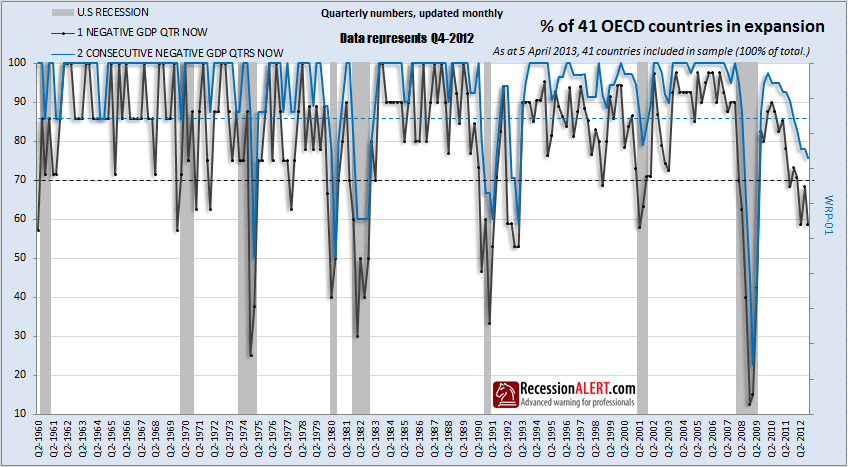
An inspection of individual countries & trading bloc’s gives one pause for some thought. Europe (25% of world GDP) and the G7 bloc (54% of GDP) are in “mild recessions” (only 1 quarter negative growth) whilst all of the “traditional recession” (at least 2 quarters negative growth) countries are isolated to Europe and make up only 9% of world GDP. Whilst the countries that are in “Expansion” make up 74.8% of world GDP, the GDP-weighted bloc shows we have tipped into “mild recession” in Q4-2012. The “non-trivial” economies that are of concern at the moment are France (4% of world GDP) , Germany (5.4%), Italy (3.2%), Spain (2.2%), UK (3.9%) and the U.S (25%) that appears on the brink.
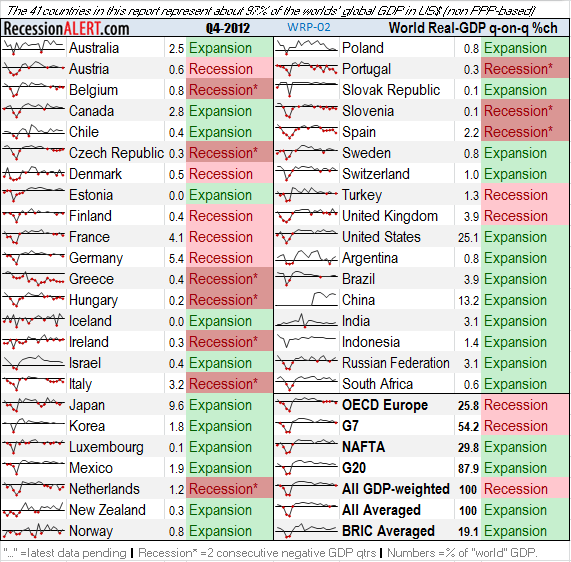
The wild card is the U.S – at 25% of world GDP. If she plunges into recession its curtains for everyone else. The initial GDP print of -0.1% gave everyone a fright (although we have always maintained this was a manifestation of the many short leading indicators that curled over 6 months back and the long-leading indicators that signalled near-recession 14-18 months back.) but this was revised up to 0.1 and then 0.4%. Taking the 0.4% final estimate reading for U.S 4Q2012 GDP and the 1st estimate for GDI, our GDP/GDI Recession Model signals 24% probability of recession:
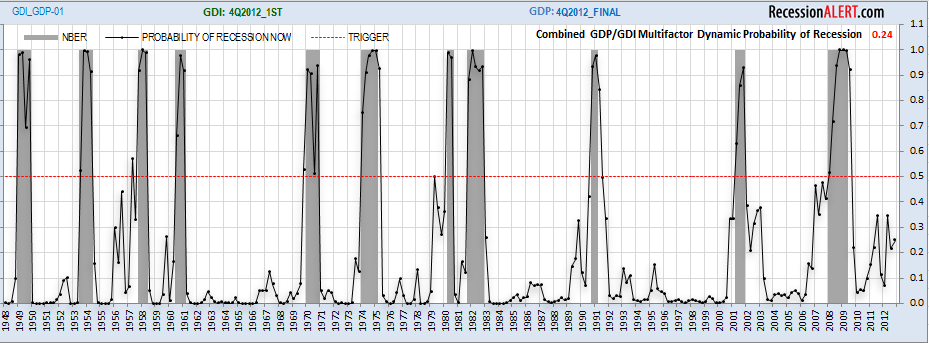
>>>EXTERNAL PUBLISHERS NOTE THAT THE CONTENT BELOW IS COPYRIGHTED AND NOT AUTHORISED FOR REPUBLISHING.
However, our Short Leading and Long leading indexes are signalling expansion ahead and should the U.S tip into technical recession, we maintain it should be mild and of short duration. Below is our own Short Weekly Leading Indicator we maintain for clients as an alternative view to that of ECRI’s (call it WLI-2). It consists of two parts, WLI-2nr which has non-revisable, non-seasonally adjusted weekly components:
- a Stock Market composite (index of most economically sensitive stocks)
- a Corporate Bond composite
- a T-Bill/Commercial paper spread composite
and WLI-2r which is WLI-2nr plus the following mildly revisable weekly updated components:
- Unemployment composite
- A Credit Spread composite (over 50 diversified credit spreads)
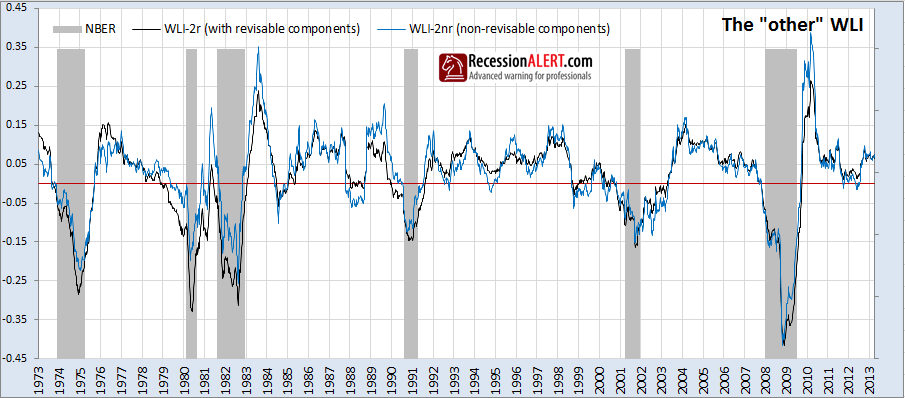
Clearly there were two near misses by WLI-2r in Oct 2011 and June 2012 with WLI-2nr (the non-revisable one) signalling mild, brief recession ahead. The important thing is not the near-misses but the slope and direction of WLI-2 since then – which is clearly up. The expectation, as business cycle theory goes, is that the GDP dip we saw is temporary. This is certainly borne out by our monthly co-incident indicator, the NBER Model, an updated image of which you can obtain from the front page of our web site, which appears to have bounced smartly since it troughed in October 2012, some 5 months after WLI-2 troughed.
Speaking of leading indicators, let us examine those of the rest of the globe to see if things are also looking up. They were just updated today (10 April) and are “fresh from the grill”. We see from below that the Global GDP-weighted LEI has stuck its head above water for the last 4 months after being under zero for the last 18 months. More importantly however, the percentage of 41 countries around the globe that have their LEI’s popping above zero is on a steep incline (as we expect and desire to indicate broad participation) and just rocketed to 70%. This basically tells us the slowdown should be over and the leading effects of each countries’ LEI’s should start taking effect on the co-incident data (such as GDP) around about now.
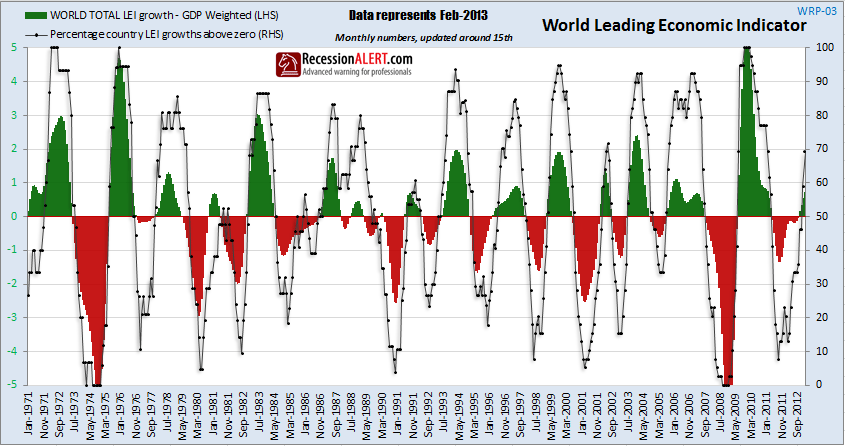
The individual country Leading Economic Indicator (LEI) details are below:
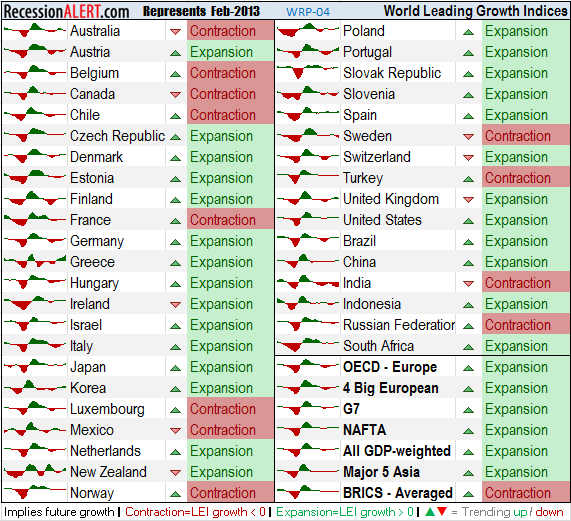
NOTE : The above charts and text are an extraction from our monthly Global Recession Report, one of 3 weekly and 5 monthly reports we issue 17 times each month for an all-inclusive $395 per annum.
